return to homepage
A Review of the Sargent/Sorolla Exhibition It has been a long time since I have gotten this excited about a show. I no longer worship Sargent as I did in the 80's, it is true; and I had already seen many of these works of his at the Whitney show 20 years ago--and in my travels since. But the opportunity to have many of the major works of Sargent and Sorolla on the same walls was a minor dream come true, since it would allow me to compare the two artists directly. It would also teach me a great deal, since these two painters are among the most talented of all time, in terms of sheer technical virtuosity and paint handling. Any student of technique--even a semi-lapsed one who had lectured for a decade against technical obsession--would find a lot of useful information on display here. And on display in the purest sense: that is to say, used in the service of beauty. If this paper was useful to you in any way, please consider donating a dollar (or more) to the SAVE THE ARTISTS FOUNDATION. This will allow me to continue writing these "unpublishable" things. Don't be confused by paying Melisa Smith--that is just one of my many noms de plume. If you are a Paypal user, there is no fee; so it might be worth your while to become one. Otherwise they will rob us 33 cents for each transaction.
return to updates
at the Petit Palais
and Bastien-Lepage at the Musee d'Orsay
by Miles Mathis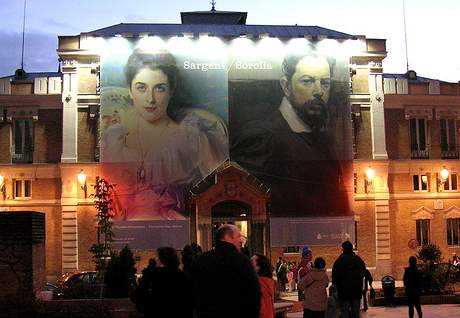
In the months leading up to this exhibition I had been travelling extensively, so I already had several museums' worth of top-notch realism freshly painted upon the walls of my brain. I had been to the Leon Bonnat museum in Bayonne, a serendipitous discovery on an overnight trainstop. I had been to the Prado and Thyssen-Bornemisza and Sorolla museums in Madrid. And I had been to the two major art museums in Scotland, the National Gallery in Edinburgh and the Kelvingrove in Glasgow. Directly after the Petit Palais, I went to the Musee d'Orsay, also in Paris, where there was a special show of Bastien-Lepage--one of Sorolla's primary influences. All this is to say that I think I can give you a pretty good overview of naturalism and its precursors here without having to hit many sources outside my short-term memory.
This exhibition [which continues until May 13--and does not, to my knowledge, travel to the US], has "benefitted from" extensive commentary in France and Spain. Meaning, by my way of looking at it, that the exhibition has been missed by almost everyone, even those who paid the money and walked through the great gates. The reviews that I have read in French tend to fall into two categories: those who say a few nice things (probably because they were asked to by the editor) but who nonetheless manage to couch the review in a dismissive tone; and those who attempt to make some substantive claims but aren't quite up to it. Also falling into this second category are the vast majority of Spanish reviews, where the critic often appears to judge the whole show with a light meter: Sorolla is brighter therefore he must be better. But to be honest, I really don't want to waste much time responding to the litterateurs and the illiterateurs, since I hope that is not why you came here. You are here searching for a sensible sentence and do not need to be told that there are few of them to be had elsewhere. If you could get them easily in other places, I would not have your ear in the first place.
I will hit one more bit of proof in this area before I move on, since it needs to be said regardless and I don't know that I can work it in later. In between long bouts of joy at being able to stand in those rooms in the museum, I have to admit that I experienced somewhat shorter bouts of anger and disbelief. The anger was caused in the first instance by finding that several of the lights were burned out in the galleries, leaving the works below them rather dark. This included Lady Agnew, who I had not seen in Edinburgh, of course, since she was here in Paris. This anger was heightened by the fact that no one on the staff at the Petit Palais seemed to care. I don't think I am rash or old-fashioned in expecting--as tat for my (rather steep) entry fee--that the curator should make a quick tour of his galleries each morning to see that the lights are functioning. I also don't think I am old-fashioned in thinking that a paying customer ought to benefit from a minimum amount of customer service, that minimum amount defined by his ability to make a complaint and have it heard by open ears. I asked several times to talk to the curator or someone in charge of the show, only to be shown a guestbook where I could make comments. I was also told that I could write a letter, which I considered very generous of them--allowing me that freedom. I can only suppose that the curator and all staff except guards do not keep daily or weekly office hours, or that once the show had been uncrated and slapped on the walls, all the administrators had gone on holiday.
So much for my anger. My disbelief was caused by the fact that no one but me appeared to notice that some canvases were mysteriously darker than others. I stood by Lady Agnew for a long time, listening to conversation. No one complained; no one noticed. I had seen the problem from across the room and had immediately looked up at the light banks. I could have fixed the problem myself in ten minutes, given a ladder (would they consider it odd if I brought my own ladder and bulbs next time, do you think?). But these others couldn't be made to see the problem even when I explained it to them. I pointed to the dark bulb in the heavens, and they looked at me like a madman or Chicken Little. "Let's move on from this strange man: he seems to have some thoughts of his own!" The guards only used me as fodder for further French mind games. When I spoke French, they spoke English; when I spoke English, they spoke French. I felt like I was trying to talk to John Cleese in a pointy hat, over a high crennelated wall. I gave up before anyone could mention my grandmother or do anything in my general direction.
I have some idea that my poor treatment was due to my dress--my equipage, my couture. I was dressed as an artist, not as a critic or maven or patron. I was wearing a Mexican shirt and was--to borrow an adjective from Don Imus--"nappy-headed". For those of you not up on the headlines, that means I had a colorful kerchief on my noggin. I also had a longish goatee, made the longer from living out of a backpack for 10 weeks without trimming scissors and all the other things people are hijacking airplanes with these days.
Perhaps I am just paranoid, but I had a strong feeling that a person in five hundred dollars worth of clothing and cosmetics might have won a few words with a curator or director--especially if the clothing or scent were Givenchy.
Whether or not that will be born out by futher investigation in heaven after we are all dead, I do definitely consider it proof of my theory that very few people actually saw the show I saw. If you can put on a major art show, and no one notices or cares that the lights are not functioning, I think you can take that as fairly strong proof that zombies have taken over the world. It would be somewhat like putting on an Olympic swimming meet and then having none of the judges, sponsors, or competitors notice that there is no water in the pool. If that happened I think it would be fair to say that swimming, as a sport, had become rather strange--rather disconnected historically from its roots and customs. 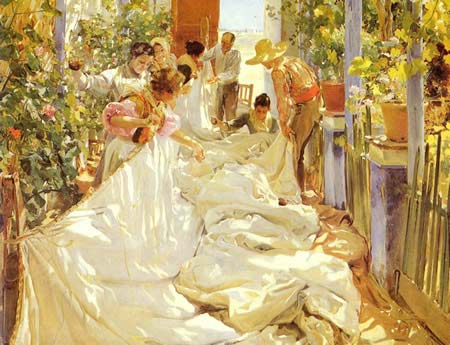
But enough of that fun. It will be sort of hard for me to crescendo after that, but I will do what I can. Two of Sorolla's masterpieces were on hand at this show, and that alone was worth the trip. I would have walked five hundred miles and I would have walked five hundred more just to be the man who looked at La Vuelta de la Pesca [Return from Fishing] and Cosienda la Vela [Mending the Sails], even in poor light. Return from Fishing had moved only across town, where it had hung way too high at the Musee d'Orsay. Here it was at the proper height, but now it was hung directly across from a giant window, which glared it out. You had to stand at an angle to see it, and no matter what you did you couldn't back far enough away to get the full effect. To achieve this you would have to crawl out the aforementioned window, swing out on a rope, and attach yourself bodily to a tree overhanging the Seine. Do you think they will mind if I bring my own rope next time?

Mending the Sails was hung without glare, thank the gods of art, but it also needed a bigger room. Paris is full of 1000 ft. rooms and 100 ft. ceilings, but for some reason the Petit Palais thought it best to hang four of Sorolla's biggest canvases in a 15 by 15 foot subroom. If I remember correctly, Paseo a Orillas del Mar (Promenade by the Sea] was on the wall directly across from Mending the Sails, so viewers of the two famous paintings had to look over, around or through eachother in order to see them.
Despite all this, Mending the Sails was a gobsmacker, nothing less. It is perfect in every way. It is magnificently conceived, masterfully constructed, and painted in the most beautiful manner imaginable. The colors, brushwork, paint quality, detail and lack of detail, focus and lack of focus, expression in the faces, setting into the background: all absolutely flawless, and more that that, absolutely gorgeous. Never before or since has a painter done a better job harmonizing a full array of natural colors. This is especially rare given the size of the work and its complexity. Sargent has some perfect canvases in this show, but none are nearly as ambitious regarding size or complexity. I remind myself of Whistler's warning that you cannot judge art based on size, but it is worth noting Sorolla's success here nonetheless. A large beauty gets no extra points over a small beauty, but everyone knows the difficulties involved in large multi-figure works outdoors. When one is painted with such a complete and astonishing success, it is due all praise. I don't care how many photographs Sorolla did or did not use, or how much model time he had or did not have. This painting is a near-miracle no matter how it was produced. Contemporary realists have an array of machines and devices unimagined by Sorolla, and yet they cannot produce anything like this. Why? We cannot seem to come up with subjects this interesting or paint them with such virtuosity. To put it another way, we simply aren't as good as Sorolla.
Return from Fishing is Sorolla's other great masterpiece here, a painting that no real painter could fail to be impressed by. It is also perfect, and perfectly astonishing in conception and execution. Sorolla could have held his own against Sargent with only these two paintings. In fact, he might have fared better with only these two. Many of Sorolla's other paintings are lovely, but none really compare to these two. And several works in this exhibition actually hurt Sorolla's reputation a bit.
These two perfect works are from early in Sorolla's career, 1896 and 1894, respectively. We only get one other major work from that period in the show--Trata de Blancas from 1895. It is not a perfect work, but in it you can also see a difference in technique from later works. A large percentage of the works by Sorolla in the show are from the period of 1905 to 1915. In them he has become somewhat lazy, relative to the previous decade. His canvases are rougher and more uneven, and this is the first clue he isn't paying full attention. He leaves globs of paint lying about on the canvas for no reason, forgets to finish other parts, also for no reason, and generally looks like he is rushing through the process. We still get some fantastic images, since Sorolla never lost his eye for the picturesque. But we are left wishing that he had spent the time on them that he spent in the early years, getting everything right. 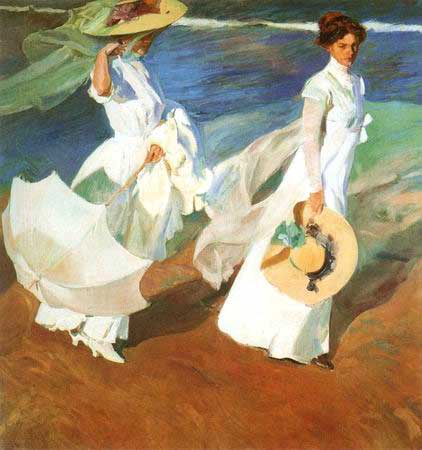
Promenade, for instance, is a gigantic sketch, very fetching indeed in conception and color. But I couldn't help thinking that it would have been even more fetching painted with the care that Mending was. These are the sort of paintings that look better scaled down on a poster or postcard, since all the flaws evaporate. But the opposite is true of Mending and Fishing: those two look ten times more impressive in a gallery than on a poster. No photograph can capture the glow and life in them. That is what painting is all about.
I have spent some time driving this point home, since I consider it to be of lasting importance in at least two ways. First, Sorolla has been very influential in contemporary realism, as everyone knows. But it seems to me that most have learned Sorolla's lesson in laziness more than his early lesson in rigor. Alla prima figure work often seems to veer into this slapdash hinting at everything. The artists think it is a sign of mastery, but to me it is usually a sign in the opposite direction. It is a cover for a lack of technical mastery. These artists simplify not in order to draw attention to forms or emotions, since they usually have none worth mentioning; they simplify because they are incapable of doing anything beyond blocking in. Sorolla's late works usually stand on their legs even without much finish, since his colors and compositions are sturdy enough to carry the burden regardless. New realists can't say the same, and a big blocked-in work just looks flabby and boring.
The other reason I mention it is to make a point in the contrary corner. I have spoken out against the retentiveness of some of the realists in the US, who paint on plastic and sand away all specks and generally worry all interest out of their paintings. I recommend Sorolla to them, as a tonic to this fussiness. Sorolla is primarily interested in his image, not his paint. He learned this from his master, Velasquez. Velasquez also often uses a rough canvas and leaves lots of specks and globs standing in his final paint layer. Both seem completely blind to any small details like this. Sorolla occasionally takes this a bit too far, as I said, as if he is doing it wilfully, but Velasquez always knows where to stop. If you are noticing the specks in a Velasquez, you are standing too close and are not looking at the painting like a painting should be looked at. The moment you look at the painting as a painting, the specks and globs disappear, and you understand why he ignored them--or used them.
This is also true regarding famous painters who are not as loose as Velasquez or Sorolla. My article about Whitaker was still in my mind as I travelled, and I noticed how many paintings by "smooth" realists were actually quite rough on closer inspection. Albert Moore, Bonnat, Burne-Jones, Millais, even Tissot. None of the great 19th century realists were as smooth as the slick new realists. Only someone like Greuze comes close to this sort of glassy finish, and he is much more technically complex than they are. That is, he is using thicker, more substantial paint, better glazing, and a better varnish, on top of images that are more substantial to begin with. This allows his best works to justify all the blending and scraping: they have some depth underneath. They are not just copies of bad photos of boring empty-headed models. In the case of Greuze, they may well be paintings of pretty little girls, but they are pretty little girls with depth, emotion, and full three-dimensionality. This is what is not being captured by the new realists, no matter how slick or rough they are.
Other works by Sorolla that I would like to mention include Maria con Sombrero, a work that clearly gave birth to the career of Joachin Torrents Llado. 
At about 18 x 40 inches, the odd shape of the canvas set an example for many succeeding realists, and it was nice to see it here. The lack of finish perfectly suits the small size, the strength of the subject and pose and color making up for the shortage of detail. Another stand out is Sorolla's portrait of his wife Clothilde sitting on a sofa. 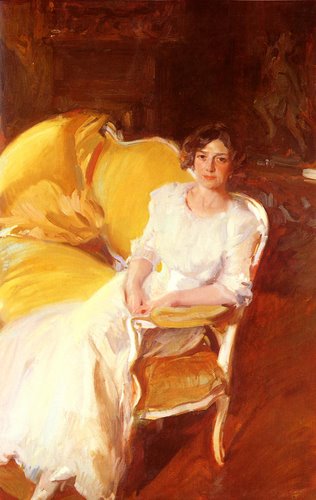
Though the light was out on this painting, it still overpowered the room it inhabited. I consider it the best portrait Sorolla had in this show. There were a couple in Madrid at the Sorolla museum that were in the same league, but they hadn't been released to travel. Also worth mentioning for a couple of reasons is Instantanea, Biarritz. 
A charming little beach scene of Clothilde all in white, this one has a secondary interest. Clothilde is holding a portable camera in her hands, as the posted museum blurb admitted. So we can be in no doubt that Sorolla had cameras available to him on the beach. This may interest those still active in the Hockney debates. But I will only point out here that the cameras did not have color film. Sorolla is famous for his color. So even if he used pictures as reference, he had to use life as well. We know he was talented enough that he didn't need projection. If he drew freehand and used life for color, it is difficult to make a case that a photo was much of a cheat. It was a logical tool, and no more. When Hockney uses an old black and white camera, without projection, to help him paint a Mending the Sails, I will buy his argument.
Before we move on to Sargent, let us look at a couple of Sorolla's failures here. Sargent doesn't have any pieces that really hurt him in this show, although a few of them do exist. But Sorolla has several here. Not surprisingly, they are all late portraits. Surprisingly, one is a portrait of his own children. 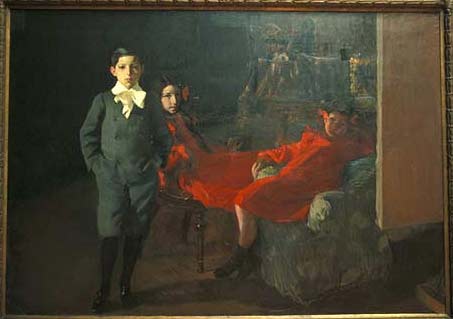
Mis Hijos, from 1904, contains a nice portrait of the boy's head. This is clearly where Sorolla started the painting. But the boy's legs don't work, and the two girls are extraneous. The composition attempts to borrow from Las Meninas, with the back of Sorolla's canvas jutting into the painting on the far right, but the entire background fails to jell. The chair is a mess and the background color is a brown muddle. Even worse is La Familia de Rafael Errazuriz, from 1905. Here we have 8 figures, all lit poorly. They are lit from one side, with half of each face in the dark. You can do this for a mysterious effect on a single portrait, I think; or, as Sargent sometimes does, on a secondary background figure. But having all eight figures lit so strangely just leaves the viewer asking questions, especially when no mystery is created by it. Here we have a rich family with beautiful children sitting in a posh room: any mystery must be manufactured. Or, if there is any real mystery--one that Sorolla is leaving clues for--I think we need more than poorly lit faces to enter into it. The best portrait in this painting is of the books in the foreground, which is obviously not the intended proper focus for a family portrait. A third failed portrait is Donna Lucrezia Arana con su Hijo, from 1906, which is unfinished in a bad way. There is no charm in its elided passages, only annoyance.
From these examples, one would come to the conclusion that Sorolla was far inferior to Sargent as a portrait painter, but I don't think that is necessarily true. Sorolla's best portraits are fantastic, and the only problem is that this exhibition showcases some of his large late portraits-- portraits that may be unfinished and that are certainly incomplete. But the same can be said of some of Sargent's late portraits. Sargent sometimes delivered canvases that clearly betrayed a lack of interest in the project--to put it nicely. But none of these canvases are included in this exhibition. Millicent, Duchess of Sutherland, is probably the worst portrait by Sargent in this exhibit, and it is still excellent. It only looks poor next to Sargent's greater works. It has the misfortune of being in the same show as Lady Agnew, Lord Dalhousie, Gitana, Coventry Patmore, the Wertheimer Children, the Misses Vickers, Ernest-Ange Duez, Violet, Homer Saint-Gaudens, and so on and on and on.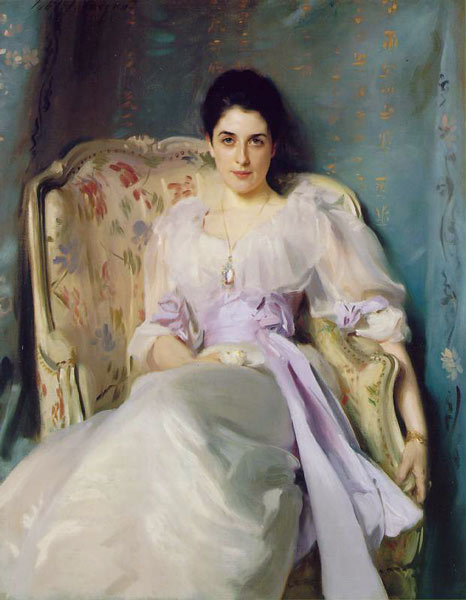
This gives the chance to switch to Sargent. Although Lady Agnew was unlit, she still managed to steal the show. It is not for nothing that this portrait has made the cover of several Sargent books over the years. I must say again here that all the various reproductions of her don't come near capturing the subtlety of her coloring. She is the ultimate proof of my claim that photography still cannot capture the gradations of life, or even of a great painting. You can tell almost nothing of a great painting from a webimage. A webimage will often help a poor painting, but it can't approach a really fine one. This doubles the danger of judging from photos, slides, or scans. Photography always does what it does to Lady Agnew on the covers of these expensive books: it adds contrast and saturation (even when there is no color shift), and we lose the slow and gentle shift of tone and color that makes a great figure painting great.
Lady Agnew was on a wall a long way away from Mending, so we are not tempted to compare them. I think we may safely say that Sargent was a more successful portrait painter and Sorolla a more successful subject painter, but I would not go further than that. It is wellnigh impossible to rank things of such elevation. Let us say that they are both among the finest things ever painted and leave it at that. It is beyond anyone but the gods to rank such things. I also found Gitana to be a thing of absolute perfection, like Velasquez's Juan de Pareja or Lady with a Fan. I have seen Gitana many times at the Metropolitan, but I never get tired of staring at her. The portrait of Homer Saint-Gaudens may be my next favorite, although I could live without his ghoulish mother in the background. 
She certainly fills a compositional place, but I am not sure that she needed to be painted with so little care. But the boy is so gorgeous and gorgeously painted you can overlook that. All the great portraitists from Titian to Sargent knew how to use black and white, and it is something we no longer take advantage of in our over-saturated new world. This costume and this pose and this expression combine to create one of the greatest children's portraits in history, I think. Sargent was and remains the foremost painter of the graceful child's pose, and it is nearly impossible to imagine--unless you have attepted to do it--how beastly difficult it is to get a child into a pose like this, much less to maintain it long enough for capture.
Even more amazing, perhaps, as a technical feat, is his ability to do it with multiple children and animals, as he does with the Wertheimer Children. 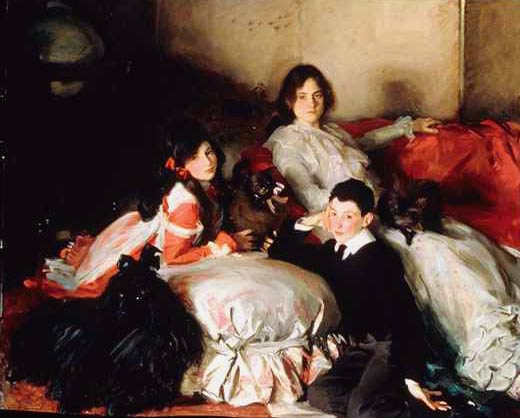
We have three children here and three dogs, all looking like they just fell off a ballet stage. And all the languid poses interlock in a composition of complex slants, perfectly balancing a large number of different angles. This was no accident, no conglomeration decided by circumstance or necessity or the camera. Sargent had to build it all from the ground up and then plug his models into it, having nothing to work with during most of the process but an image in his head and a few sketches. The dogs are not the least of it, either, since Sargent did not farm out his animals and backgrounds like Van Dyck and most of the other big names of history. Every mark here is Sargent and Sargent alone, and it shows in the consistency of the work. Because he is spending such time on backgrounds and dogs and things, he is able to also control the color in the sublest ways, creating a harmony that is perfect. Sargent never gets any credit as a colorist, simply because he doesn't use a lot of bright colors and hot primaries; but Sargent was a great colorist, in fact, since he was able to harmonize colors better than almost anyone. His canvases have a subtle calm, and this is created by backgrounds that perfectly harmonize his skintones and dress tones. This is not an easy thing to do. We have proof of this from Sorolla himself, who, despite his prodigious talent for color, shows us how easily things can go wrong. Directly across from The Wertheimer Children hung all of Sorolla's failed portraits I mentioned above. In them we can see how a bad color in a background can throw an entire harmony out of whack, despite the most graceful brushwork in the world. Sorolla is unfortunate to have these canvases in the same room as The Wertheimer Children and The Misses Vickers, both of which deliver the whole package faultlessly.
To go back to The Wertheimer Children, here we find Sargent creating a color harmony that is second to no one, not even Titian or Whistler, and he does this despite the fact that he is using a fairly hot red in the couch (indeed one might call it a Titian red). Someone like Pino would try to harmonize this red with a light, shadowless background and a lot of middle pinks, creating a horrible kitschy mess, but Sargent chooses a range of blacks and near blacks instead, greening out his black where it hits a red, for instance, and pushing it slightly toward purple in other places.
You have to have a natural feel for this sort of thing, and Sargent certainly had it. By the 1880's he could already make up backgrounds from whole cloth, never creating a tone that clashed in even the smallest way. Most think he did this by staying very close to grey all the time, but this is not true. Walter Sickert accused Sargent of being a poor colorist, but it was Sickert himself that was nearly tone-blind. Sargent's colors are lovely and natural, without ever being keyed up. It was this lack of exaggeration in an exaggerated milieu that hurt him with the critics, and this problem remains for realists today--we who must compete with Hollywood and advertising and Disney. If you paint natural levels of color, you will be accused of being bland. The real world just isn't good enough for a lot of people.
OK, enough of my Sargentolatry. I was supposed to have gotten past that, wasn't I? Let us move on to Bastien-Lepage. The organizers could easily have made this a triple show, since Bastien-Lepage was one of Sorolla's teachers, in a way. We are told this by the newest literature, and it is not hard to see. Sorolla's early works betray this influence very strongly, since in them he retains the rigor and strength of Bastien-Lepage's tighter brush. The best place to see this is in the hands, where Bastien-Lepage, despite being mainly an alla prima painter like Sargent, nonetheless builds his skintones from multiple dry layers, or scumbles. What I mean by this is that Bastien-Lepage, like Waterhouse or even Rembrandt, skips doing an underpainting. These artists don't do a grisaille and then color it with glazes. Instead, they do what most of us would consider to be a finished alla prima painting, they let that dry, and then they paint other heavy layers right over the top of that. They also use glazes, but only where they need them. They don't need them everywhere since the first layer was already in full color, or near to it. This gives Waterhouse and Bastien-Lepage the looseness of Sargent combined with the rigor and power of Rembrandt. These are canvases that have been worked on for a long time, and they look it. They are alla prima, in a way, but they aren't au premier coup. Sorolla's work in the 80's and 90's also has this feel, although he rarely achieves the layers that Bastien-Lepage does. From the beginning, Sorolla was interested in getting an effect in the most efficient manner, and even early on we can see him aiming, as it were, for the one-layer sketch he would use for the beach scenes in 1909.
Sargent is famous for seeing a Bastien-Lepage and saying, "Tricks!" What did he mean by that? One thing he meant is that he looked down on painters like this for not getting it all done in one layer. Sargent didn't like scumbles. He used a few glazes, but Sargent prided himself on his technique, and part of his technique was avoiding "unnecessary" blends and scumbles. He didn't even like to admit that he blended one tone into the next (though of course he did), implying that he always created gradations or smoothness with a further middletone. The other thing Sargent no doubt meant is that Bastien-Lepage textured his canvas in places prior to painting on it. Sargent considered this to be a dishonest way of creating paint thickness. It seems to me that Bastien-Lepage mainly did this in backgrounds, beneath foliage and grass and so on, so I don't really see Sargent's point. In my opinion, Sargent just needed something to say, and that is what came down to us. Had he realized he was creating a quote for posterity, he might have kept quiet, or said something completely different.
There is a strangeness to a lot of Bastien-Lepage's work, especially his early work. Some of them are very odd. Despite being very naturalistic in lighting and detail, they have an otherworldy quality, like Puvis de Chavannes. It takes a bit of getting used to, but by the end of the day I decided I liked it.
Almost all of Bastien-Lepage's major works were included in this show, except Joan of Arc--who was too big to travel or wouldn't fit in these side rooms at the d'Orsay. Even the somewhat smaller works that did make it to Paris felt cramped here. The d'Orsay is a lovely venue for sculpture, but it has not been possible to turn this train station into a proper gallery for paintings. Only a minority of the permanent collection looks its best here, and the Bastien-Lepage show was not treated with all due respect. The star of the show, in my mind, was the London Flower Girl, but she was hung in a room with a low ceiling, so that the light was too close to her, glaring out the top half of the work. And, as in the Petit Palais, the smallness of the room prevented one from backing away to correct this. You simply could not find a proper viewing angle. The Bootblack and Pas Meche, in the same room, suffered the same fate. 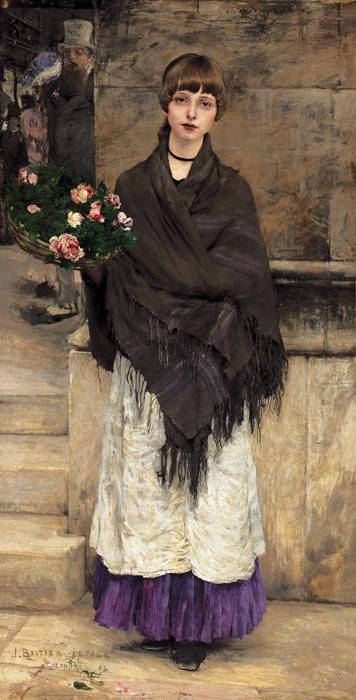
These three canvases are representative of Bastien-Lepage's tendency to concentrate on a single figure. He places his figure in the center of the canvas and has him or her stare strongly straight ahead, feet very near the bottom of the picture. I find this compelling--as you might expect, given my oeuvre--and the Parisians of the time agreed; but many appear to have found this monotonous, contrived, or lacking in imagination. This combination of immediacy and oddity is what made Bastien-Lepage's name at the Salon in the 70's, and made him famous by the time he died at age 36, so it might be worthwhile pursuing the method a bit further. Bastien-Lepage's work generally has more of a snapshot look to it than the work of other artists of the time, even Sargent or Degas. We know that both Degas and Bastien-Lepage used photos, so this look is not a accident. Like Degas, Bastien-Lepage experimented with the novelty of this perspective and cropping on purpose. He also liked to put his still figure in a busier scene, and to try to capture both the stillness and the motion. 
The Bootblack is the clearest example of this, with the carriages and horses jostling--almost tipping--in the background. This concurrent depiction of motion and stillness had only recently been captured by photography, and in painting it was still a novelty. But Bastien-Lepage went even further, since he carried into this scene the natural oddity he already possessed. He had always painted children like little ghosts or fays, with faraway eyes and preternatually world-weary expressions. The same weird expression that makes Pauvre Fauvette so mysterious finds a place in every one of Bastien-Lepage's paintings, from Joan of Arc to The Beggar, where we find the faerie urchin hiding in the doorway. 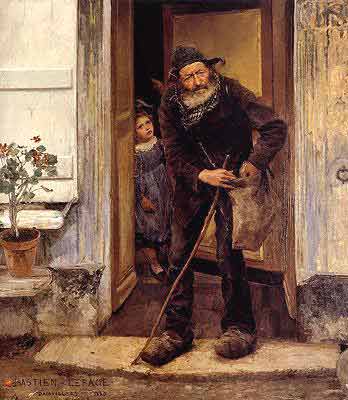
I first saw The Beggar at the Glyptotech in Copenhagen--where it was better lit. It is one of the artist's best-known, and for good reason: it is a masterwork in all respects. Bastien-Lepage always loved the big boots and the ill-fitting clothes, and here he has found the ultimate artistic excuse for them. His model is perfectly chosen and perfectly depicted: we do not question the faraway, almost demented, look here. We have entered the nursery rhyme, led by the great artist as illustrator, and all is as it should be. We can feel the wind blow and the cool snap of October.
Bastien-Lepage is not as consistent as Sargent or as ambitious as Sorolla. We get no Mending the Sails from him. Joan of Arc is about the same size, but we only have one figure (not including the ghostly saints in the trees). Still, at his best, Bastien-Lepage is as good as anyone at the end of the 19th century. His strengths far outweigh his weaknesses, and he undeniably takes us to an appealing world that is all his own. It is a pity that he died so young, at the height of his career. We can be sure that he would have thrilled us with many more important paintings.
All in all, Paris was a great place to be, whether at the end of the 19th century, for the three artists reviewed here; or for me, this month. It was a real treat to see these three favorites at the same time, and to see two of them in the same rooms. The exhibitions stand as a reminder of many things, not least of how much we have left to do to match the achievements of our mentors and teachers.